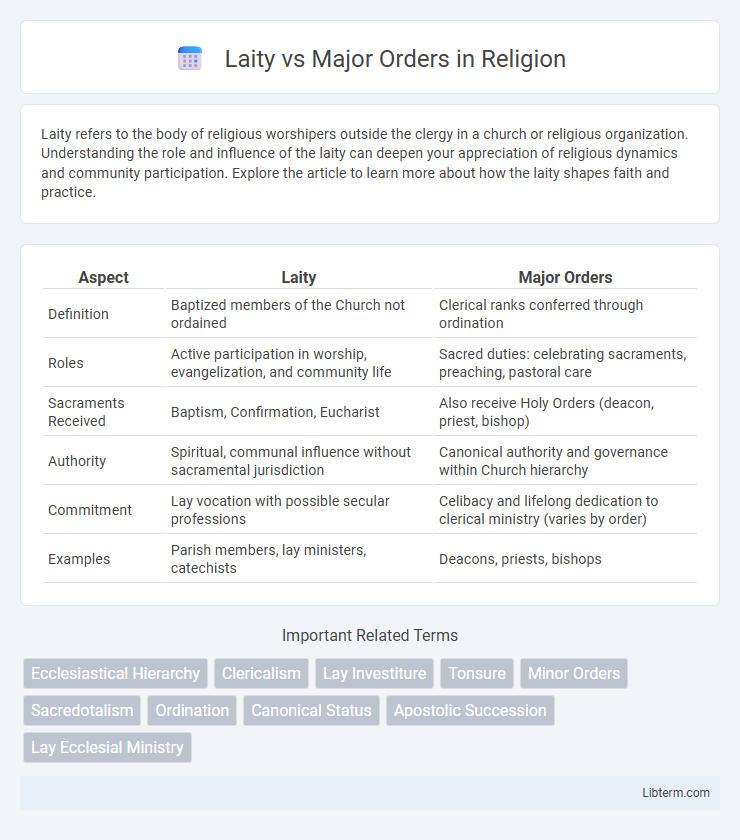Laity refers to the body of religious worshipers outside the clergy in a church or religious organization. Understanding the role and influence of the laity can deepen your appreciation of religious dynamics and community participation. Explore the article to learn more about how the laity shapes faith and practice.
Table of Comparison
| Aspect | Laity | Major Orders |
|---|---|---|
| Definition | Baptized members of the Church not ordained | Clerical ranks conferred through ordination |
| Roles | Active participation in worship, evangelization, and community life | Sacred duties: celebrating sacraments, preaching, pastoral care |
| Sacraments Received | Baptism, Confirmation, Eucharist | Also receive Holy Orders (deacon, priest, bishop) |
| Authority | Spiritual, communal influence without sacramental jurisdiction | Canonical authority and governance within Church hierarchy |
| Commitment | Lay vocation with possible secular professions | Celibacy and lifelong dedication to clerical ministry (varies by order) |
| Examples | Parish members, lay ministers, catechists | Deacons, priests, bishops |
Understanding Laity and Major Orders
Understanding laity involves recognizing laypeople as baptized members of the Church who do not hold clerical or major orders, actively participating in the faith through worship, service, and evangelization. Major orders, historically including the roles of bishop, priest, and deacon, signify ordained clergy entrusted with sacramental and pastoral responsibilities essential to Church governance and spiritual leadership. Distinguishing between laity and major orders clarifies the Church's hierarchical structure and the unique functions each group fulfills within ecclesial life.
Historical Context of Laity vs Major Orders
The historical context of laity versus major orders traces back to the early Christian Church, where the division between ordained clergy and non-ordained faithful became formalized during the Middle Ages. Major orders, including bishops, priests, and deacons, held sacramental and administrative authority, while the laity comprised baptized Christians without clerical status, primarily responsible for secular and communal participation. This hierarchical structure shaped ecclesiastical governance, influencing theological debates and church reforms throughout history.
Roles and Responsibilities: Laity vs Clergy
Laity primarily participates in worship, community service, and evangelization within the church, supporting the mission through activities like charity work and lay ministry. Clergy, especially those in Major Orders such as deacons, priests, and bishops, perform sacramental duties including administering the Eucharist, preaching, and pastoral care. The distinct responsibilities emphasize the laity's role in everyday faith expression and the clergy's leadership in liturgical functions and church governance.
Theological Foundations of Major Orders
Theological foundations of Major Orders are deeply rooted in the sacramental theology of the Church, emphasizing the distinct roles of clergy as mediators between God and the laity. Major Orders--comprising episcopate, presbyterate, and diaconate--carry the grace necessary for sacramental administration and pastoral governance, which the Church believes are essential for maintaining apostolic succession and ecclesial unity. Unlike the laity, who participate in the priesthood of all believers through baptism and confirmation, those in Major Orders receive a sacramental character that configures them to Christ for the sacred service of the Church.
Liturgical Functions: Distinctions and Overlaps
Laity participate in liturgical functions primarily through roles such as readers, choir members, and Eucharistic ministers, supporting communal worship without sacramental authority. Major Orders, including bishops, priests, and deacons, carry distinct sacramental responsibilities like consecrating the Eucharist, preaching, and administering sacraments, which laity cannot perform. Overlaps occur in ministries like lectoring and distributing communion when authorized, reflecting a collaborative but hierarchical liturgical structure.
Authority and Leadership in the Church
Laity in the Church comprises baptized members without sacramental ordination, participating primarily in the community's spiritual life and mission without holding formal authority or governance roles. Major Orders, including bishops, priests, and deacons, possess ordained authority and leadership, responsible for teaching doctrine, administering sacraments, and governing the Church's hierarchical structure. This distinction underscores the clerical hierarchy's exclusive role in ecclesiastical decision-making and sacramental ministry, differentiating ordained leadership from the participatory role of lay faithful.
Participation of the Laity in Church Life
The participation of the laity in church life has expanded significantly beyond traditional roles, emphasizing active involvement in liturgical functions, catechesis, and parish administration. Unlike major orders--such as deacon, priest, and bishop--laity do not receive sacramental ordination but contribute through ministries like lectors, Eucharistic ministers, and pastoral counselors. This inclusive engagement fosters a collaborative church community, reflecting Vatican II's call for the laity's vital role in evangelization and mission.
Vocational Callings: Clergy and Lay Perspectives
Vocational callings in Christianity distinguish between the laity, who engage in secular and church-related roles without sacramental ordination, and the major orders of clergy, including deacons, priests, and bishops, who receive sacramental ordination to perform liturgical and pastoral duties. The laity contribute through ministries such as catechesis, evangelization, and community service, while clergy are called to lead worship, administer sacraments, and provide spiritual guidance. Both perspectives emphasize distinct but complementary roles in fulfilling the Church's mission and nurturing the faith community.
Modern Challenges and Developments
Modern challenges in the relationship between laity and major orders center on evolving roles within religious institutions and increasing calls for inclusivity and lay participation. Developments include the growing emphasis on lay ministries, theological education for non-ordained members, and debates over clerical authority and gender roles. These shifts reflect broader societal changes, prompting institutions to reconsider traditional hierarchies and adapt to contemporary expectations for leadership and service.
Bridging the Gap: Fostering Collaboration
Bridging the gap between laity and major orders enhances collaboration by promoting mutual respect and shared responsibilities within church communities. Empowering laity through education and active participation in liturgical and pastoral functions fosters a unified approach to ministry alongside ordained clergy. This synergy strengthens ecclesial life, ensuring diverse gifts contribute to the church's mission and growth.
Laity Infographic

 libterm.com
libterm.com